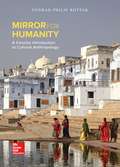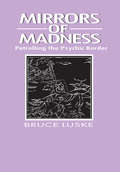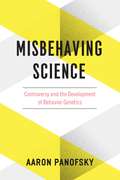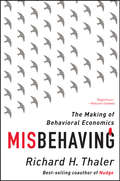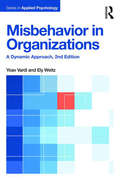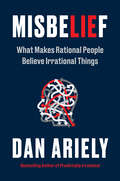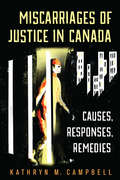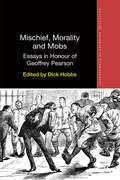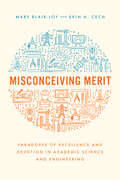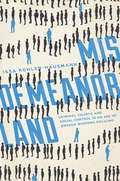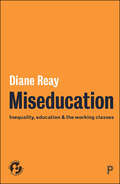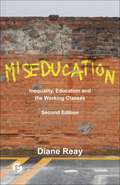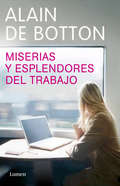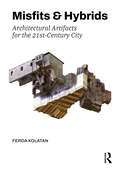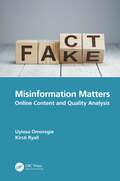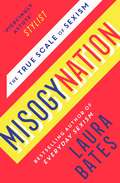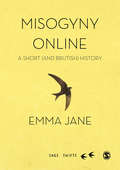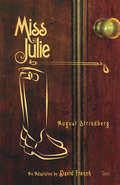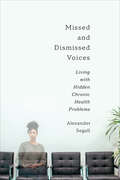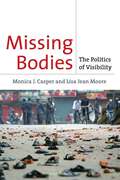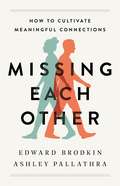- Table View
- List View
Mirror for Humanity: A Concise Introduction to Cultural Anthropology (Tenth Edition)
by Conrad Phillip KottakWritten by a prominent scholar in the field, Conrad Phillip Kottak, this concise, student-friendly, current introduction to cultural anthropology carefully balances coverage of core topics and contemporary changes in the field. New to this edition, Connect Anthropology offers a variety of learning tools and activities to make learning more engaging for students and teaching more efficient for instructors. Mirror for Humanity is a perfect match for cultural anthropology courses that use readings or ethnographies along with a main text.
Mirrored Spaces: Social Inequality in the Digital Age (Geographies of Media)
by Jörg SchefferThis open access book critically examines discussions on digitalisation and individual opportunities for socio-economic advancement. Contrary to the prevailing narratives of “digital empowerment” and opportunities for every individual, this book argues that digitalisation massively curtails social advancement opportunities, consolidating existing social relations. From a spatial perspective, Scheffer demonstrates how socially disadvantaged groups are faced with reproducing mechanisms as part of a new data economy. Surprisingly, the more intensively digital services are used, the more this happens.Building on Löw´s sociology of space and Bourdieu´s concept of habitus, this book shows how practices of social exclusion are transferred to the digital present in an innovative way. The image of “mirrored” spaces describes a new mechanism that explains social exclusion in the age of digitalisation. This book is an essential resource for researchers and students interested in socio-economic inequalities, processes of digitalisation, and digital geographies.
Mirrors of Madness: Patrolling the Psychic Border (Social Problems And Social Issues Ser.)
by Bruce LuskeMirrors of Madness depicts the social-psychological processes and institutional consequences of psychiatric staffs experience of ""closet insanity"" (private worries about theirown social and psychological competence) and ""reverse role modeling"" (identification with their labeled psychotic clients' public behavior).The book shows how, in attempting to ward off the threat involved in these processes, staffs tend to be more vigilant of their own behavior while redirecting their insecurities toward their clients in the form of derogatory humor in psychiatric evaluations. These and other activities are shown to be inhibiting factors in the rehabilitative function of social control agencies.
Misbehaving Science: Controversy and the Development of Behavior Genetics
by Aaron PanofskyBehavior genetics has always been a breeding ground for controversies. From the “criminal chromosome” to the “gay gene,” claims about the influence of genes like these have led to often vitriolic national debates about race, class, and inequality. Many behavior geneticists have encountered accusations of racism and have had their scientific authority and credibility questioned, ruining reputations, and threatening their access to coveted resources. In Misbehaving Science, Aaron Panofsky traces the field of behavior genetics back to its origins in the 1950s, telling the story through close looks at five major controversies. In the process, Panofsky argues that persistent, ungovernable controversy in behavior genetics is due to the broken hierarchies within the field. All authority and scientific norms are questioned, while the absence of unanimously accepted methods and theories leaves a foundationless field, where disorder is ongoing. Critics charge behavior geneticists with political motivations; champions say they merely follow the data where they lead. But Panofsky shows how pragmatic coping with repeated controversies drives their scientific actions. Ironically, behavior geneticists’ struggles for scientific authority and efforts to deal with the threats to their legitimacy and autonomy have made controversy inevitable—and in some ways essential—to the study of behavior genetics.
Misbehaving: The Making of Behavioral Economics
by Richard H. ThalerGet ready to change the way you think about economics. Richard H. Thaler has spent his career studying the radical notion that the central agents in the economy are humans--predictable, error-prone individuals. Misbehaving is his arresting, frequently hilarious account of the struggle to bring an academic discipline back down to earth--and change the way we think about economics, ourselves, and our world. Traditional economics assumes rational actors. Early in his research, Thaler realized these Spock-like automatons were nothing like real people. Whether buying a clock radio, selling basketball tickets, or applying for a mortgage, we all succumb to biases and make decisions that deviate from the standards of rationality assumed by economists. In other words, we misbehave. More importantly, our misbehavior has serious consequences. Dismissed at first by economists as an amusing sideshow, the study of human miscalculations and their effects on markets now drives efforts to make better decisions in our lives, our businesses, and our governments. Coupling recent discoveries in human psychology with a practical understanding of incentives and market behavior, Thaler enlightens readers about how to make smarter decisions in an increasingly mystifying world. He reveals how behavioral economic analysis opens up new ways to look at everything from household finance to assigning faculty offices in a new building, to TV game shows, the NFL draft, and businesses like Uber. Laced with antic stories of Thaler's spirited battles with the bastions of traditional economic thinking, Misbehaving is a singular look into profound human foibles. When economics meets psychology, the implications for individuals, managers, and policy makers are both profound and entertaining.
Misbehavior in Organizations: A Dynamic Approach (Applied Psychology Series)
by Yoav Vardi Ely WeitzThis revised edition of Misbehavior in Organizations updates and expands upon the integrative OMB (organizational misbehavior) framework pioneered by the authors. Streamlined for improved readability, it covers key topics that have emerged in the scholarly literature in the past decade including insidious workplace behavior, bullying and harassment in the workplace, information hiding, cyberbullying, and organizational spirituality. A thorough and up-to-date resource on this crucial and evolving topic in organizational studies, this book provides insights on misbehavior at the individual, position, group, and organizational levels.
Misbelief: What Makes Rational People Believe Irrational Things
by Dr. Dan ArielyThe renowned social scientist, professor, and bestselling author of Predictably Irrational delivers his most urgent and compelling book—an eye-opening exploration of the human side of the misinformation crisis—examining what drives otherwise rational people to adopt deeply irrational beliefs. Misinformation affects all of us on a daily basis—from social media to larger political challenges, from casual conversations in supermarkets, to even our closest relationships. While we recognize the dangers that misinformation poses, the problem is complex—far beyond what policing social media alone can achieve—and too often our limited solutions are shaped by partisan politics and individual interpretations of truth.In Misbelief, preeminent social scientist Dan Ariely argues that to understand the irrational appeal of misinformation, we must first understand the behavior of “misbelief”—the psychological and social journey that leads people to mistrust accepted truths, entertain alternative facts, and even embrace full-blown conspiracy theories. Misinformation, it turns out, appeals to something innate in all of us—on the right and the left—and it is only by understanding this psychology that we can blunt its effects. Grounded in years of study as well as Ariely’s own experience as a target of disinformation, Misbelief is an eye-opening and comprehensive analysis of the psychological drivers that cause otherwise rational people to adopt deeply irrational beliefs. Utilizing the latest research, Ariely reveals the key elements—emotional, cognitive, personality, and social—that drive people down the funnel of false information and mistrust, showing how under the right circumstances, anyone can become a misbeliever.Yet Ariely also offers hope. Even as advanced artificial intelligence has become capable of generating convincing fake news stories at an unprecedented scale, he shows that awareness of these forces fueling misbelief make us, as individuals and as a society, more resilient to its allure. Combating misbelief requires a strategy rooted not in conflict, but in empathy. The sooner we recognize that misbelief is above all else a human problem, the sooner we can become the solution ourselves.
Miscarriages of Justice in Canada: Causes, Responses, Remedies
by Kathryn CampbellInnocent people are regularly convicted of crimes they did not commit. A number of systemic factors have been found to contribute to wrongful convictions, including eyewitness misidentification, false confessions, informant testimony, official misconduct, and faulty forensic evidence. In Miscarriages of Justice in Canada, Kathryn M. Campbell offers an extensive overview of wrongful convictions, bringing together current sociological, criminological, and legal research, as well as current case-law examples. For the first time, information on all known and suspected cases of wrongful conviction in Canada is included and interspersed with discussions of how wrongful convictions happen, how existing remedies to rectify them are inadequate, and how those who have been victimized by these errors are rarely compensated. Campbell reveals that the causes of wrongful convictions are, in fact, avoidable, and that those in the criminal justice system must exercise greater vigilance and openness to the possibility of error if the problem of wrongful conviction is to be resolved.
Mischief, Morality and Mobs: Essays in Honour of Geoffrey Pearson (Routledge Advances in Ethnography)
by Dick HobbsGeoffrey Pearson, who died in 2013, was one of the outstanding social scientists of the post second world war era. His work spanned social work, social theory, social history, criminology and sociology. In particular, his work has had a huge impact upon studies of youth, youth culture and drugs. This collection is made up of contributions from scholars producing empirical work on some of the key areas upon which Geoff Pearson established his reputation. All of the writers in this collection have been profoundly influenced by his scholarship. This collection focuses on urban ethnography, race and ethnicity, youth, and drugs. It includes chapters on: women working in male boxing gyms; understanding the English Defence League; Black male adults as an ignored societal group; drug markets and ethnography; and sex, drugs and kids in care. The result is a cutting edge collection that takes readers into social worlds that are difficult to access, complex, yet utterly normal. Overall this is an exciting and fittingly challenging tribute to one of the UKs most important scholars. This volume will appeal to scholars and students of criminology, sociology, social history and research methodology – in particular ethnography.
Misconceiving Merit: Paradoxes of Excellence and Devotion in Academic Science and Engineering
by Mary Blair-Loy Erin A. CechAn incisive study showing how cultural ideas of merit in academic science produce unfair and unequal outcomes. In Misconceiving Merit, sociologists Mary Blair-Loy and Erin A. Cech uncover the cultural foundations of a paradox. On one hand, academic science, engineering, and math revere meritocracy, a system that recognizes and rewards those with the greatest talent and dedication. At the same time, women and some racial and sexual minorities remain underrepresented and often feel unwelcome and devalued in STEM. How can academic science, which so highly values meritocracy and objectivity, produce these unequal outcomes? Blair-Loy and Cech studied more than five hundred STEM professors at a top research university to reveal how unequal and unfair outcomes can emerge alongside commitments to objectivity and excellence. The authors find that academic STEM harbors dominant cultural beliefs that not only perpetuate the mistreatment of scientists from underrepresented groups but hinder innovation. Underrepresented groups are often seen as less fully embodying merit compared to equally productive white and Asian heterosexual men, and the negative consequences of this misjudgment persist regardless of professors’ actual academic productivity. Misconceiving Merit is filled with insights for higher education administrators working toward greater equity as well as for scientists and engineers striving to change entrenched patterns of inequality in STEM.
Misdemeanorland: Criminal Courts and Social Control in an Age of Broken Windows Policing
by Issa Kohler-HausmannAn in-depth look at the consequences of New York City’s dramatically expanded policing of low-level offensesFelony conviction and mass incarceration attract considerable media attention these days, yet the most common criminal-justice encounters are for misdemeanors, not felonies, and the most common outcome is not prison. In the early 1990s, New York City launched an initiative under the banner of Broken Windows policing to dramatically expand enforcement against low-level offenses. Misdemeanorland is the first book to document the fates of the hundreds of thousands of people hauled into lower criminal courts as part of this policing experiment.Drawing on three years of fieldwork inside and outside of the courtroom, in-depth interviews, and analysis of trends in arrests and dispositions of misdemeanors going back three decades, Issa Kohler-Hausmann argues that lower courts have largely abandoned the adjudicative model of criminal law administration in which questions of factual guilt and legal punishment drive case outcomes. Due to the sheer volume of arrests, lower courts have adopted a managerial model--and the implications are troubling. Kohler-Hausmann shows how significant volumes of people are marked, tested, and subjected to surveillance and control even though about half the cases result in some form of legal dismissal. She describes in harrowing detail how the reach of America's penal state extends well beyond the shocking numbers of people incarcerated in prisons or stigmatized by a felony conviction.Revealing and innovative, Misdemeanorland shows how the lower reaches of our criminal justice system operate as a form of social control and surveillance, often without adjudicating cases or imposing formal punishment.
Miseducation: Inequality, Education and the Working Classes (21st Century Standpoints)
by Diane ReayIn this book Diane Reay, herself working class turned Cambridge professor, brings Brian Jackson and Dennis Marsden’s pioneering Education and the Working Class from 1962 up to date for the 21st century.Drawing on over 500 interviews, the book, part of the 21st Century Standpoints series published in association with the British Sociological Association, includes rich, vivid stories from working class children and young people. It looks at class identity, the inadequate sticking plaster of social mobility, and the effects of wider economic and social class relationships on working class educational experiences.The book addresses the urgent question of why the working classes are still faring so much worse than the upper and middle classes in education. It reveals how we have ended up with an educational system that still educates the different social classes in fundamentally different ways, and vitally – what we can do to achieve a fairer system.
Miseducation: Inequality, Education and the Working Classes (21st Century Standpoints)
by Diane ReayEducation is supposed to level the playing field, and yet for many working-class children inequalities in the classroom in fact deepen the divide. Students from disadvantaged backgrounds are almost four times more likely to be excluded from school than their wealthier peers and many are struggling in an educational environment increasingly concerned with discipline. In this substantially revised and updated edition of her bestselling book, Diane Reay – herself working class turned Cambridge professor – investigates why we educate social classes so differently. Drawing on extensive interviews with working class children and young people, Miseducation offers a sharp critique of how class identity, social mobility, and entrenched inequalities shape educational outcomes. It also examines the increasing focus on control and discipline in UK schools and charts the impact of policies like academies on working-class students. In a new chapter, Reay draws lessons from educational systems around the world, while a second presents clear recommendations for creating a system that supports every child’s potential. Insightful and thought-provoking, this book is essential reading for anyone invested in the future of education and social equity.
Miserias y esplendores del trabajo
by Alain de BottonUna reflexión irónica sobre el mundo del trabajo y del consumo El autor mismo define su libro como un himno a la inteligencia, peculiaridad, la belleza y el horror de los lugares de trabajo y al hecho extraordinario de que el trabajo sea, junto al amor, la principal fuente de sentido de nuestra vida. Hace poco más de un siglo, nuestros antepasados sabían todavía el origen preciso de lo que poseían y comían. Estaban familiarizados con los animales, las herramientas y tenían una relación cómplice con su entorno de trabajo. Ahora, todo nos llega envuelto en fundas cargadas de etiquetas y poco falta para que los niños crean que los pollos nacen en los supermercados. Dispuesto a romper esta barrera, Alain de Botton se aventura primero a darse un paseo por los muelles del puerto de Londres, para desplazarse luego a una fábrica de galletas en el interior del país, luego viaja a las Maldivas con los pescadores encargados de unafábrica de conservas para acabar en los despachos de una empresa que se dedica a la contabilidad. Lo que más le interesa es hablar con las personas que están cerca de los procesos productivos para ilustrar las peculiaridades del "homo faber", y las bondades de casi cualquier trabajo cuando lo examinamos de cerca. Tras estas conversaciones, nada es igual ya: la cereza que corona una galleta, la tapicería de un avión o una lata cualquiera de sardinas tienen a alguien con cara y ojos que estuvo al cargo de su proceso, y de repente el trabajo se vuelve algo menos abstracto y más cercano a los anhelos y las angustias del ser humano. Culto, irónico, maestro de la anécdota, Alain de Botton nos habla de Diderot y Voltaire mientras camina por los hangares de una gran fábrica y reflexiona sobre la naturaleza del arte mientras recorre las líneas de una central eléctrica. «Prepararse para la muerte con preceptos sabios es ofrecerle demasiado respeto. Dejemos que nos sorprenda mientras transportamos pasta de madera o buscamos la mejor manera de fabricar un frasco de perfume: hagamos que la muerte nos pille mientras hacemos algo para la vida.» Con estas palabras se cierra el libro y se abren un montón de puertas insólitas para el lector. La crítica ha dicho:«Si es que todavía hace falta hablar de las bondades de un escritor como Alain de Botton, pues les diré que en Miserias y esplendores del trabajo este hombre se supera a sí mismo en la perspicacia de sus reflexiones y en su complicidad con el ser humano.»Geoff Dyer «De Botton te lleva a pensar en cómo vives pero, sobre todo, en cómo podrías vivir.»The Times
Misfits & Hybrids: Architectural Artifacts for the 21st-Century City
by Ferda KolatanContemporary cities are shaped by the unlikely adjacencies of objects that are vastly different in kind, origin, and scale: buildings, infrastructure, and other urban components that over time accumulate into mismatched configurations. However, despite the ubiquity of these oddities and their impact on the city, we rarely give them much consideration. In Misfits & Hybrids, Ferda Kolatan explores the untapped potential in these unexpected conditions for a new kind of architecture. A diverse array of projects, developed in Kolatan’s design studios at the University of Pennsylvania Weitzman School of Design, illustrates how hybrid artifacts can reveal the often overlooked cultural, socio-political, and material histories of a site, fostering design tactics invested in reinventing the existing. Set within the cosmopolitan megacities of Istanbul, Cairo, and New York, the projects are conceived as real fictions, conjuring novel narrative, aesthetic, and representational forms to reflect the pluralistic postindustrial city.
Misinformation Matters: Online Content and Quality Analysis
by Uyiosa Omoregie Kirsti RyallWhat is "misinformation"? Why does it matter? How does it spread on the internet, especially on social media platforms? What can we do to counteract the worst of its effects? Can we counteract its effects now that it is ubiquitous? These are the questions we answer in this book. We are living in an information age (specifically an "algorithmic age") which prioritizes information "quantity" over "quality". Social media has brought billions of people from across the world together online and the impact of diverse platforms, such as Facebook, WeChat, Reddit, LinkedIn, Signal, WhatsApp, Gab, Instagram, Telegraph, and Snapchat, has been transformational. The internet was created, with the best of intentions, as an online space where written content could be created, consumed and diffused without any real intermediary. This empowering aspect of the web is still, mostly, a force for good. People, on the whole, are better informed and online discussion is more inclusive because barriers to participation are reduced. As activity online has grown, however, an expanding catalogue of research reveals a darker side to social media, and the internet generally. Namely, misinformation’s ability to negatively influence our behaviour both online and offline. The solution we provide to this growing dilemma is informed by Ludwig Wittgenstein’s Tractatus Logico-Philosophicus, which examines the relationship between language and reality from a philosophical perspective, and complements Claude Shannon’s Information Quantity Theory, which addresses the quantification, storage and communication of digital information from a mathematical perspective. The book ends by setting out a model designed by us: a "Wittgensteinian" approach to information quality. It defines content published online by clarifying the propositions and claims made within it. Our model’s online information quality check allows users to effectively analyse the quality of trending online content. This approach to misinformation analysis and prevention has been designed to be both easy to use and pragmatic. It upholds freedom of speech online while using the "harm principle" to categorise problematic content.
Misogynation: The True Scale Of Sexism
by Laura BatesA COLLECTION OF ESSAYS FROM BESTSELLING AUTHOR AND FOUNDER OF THE EVERYDAY SEXISM PROJECT, LAURA BATES. 'Following [Everyday Sexism] will make most women feel oddly saner.' Caitlin Moran 'Piercingly astute.' StylistLaura Bates, pioneering feminist, activist and bestselling author, has given voice to hundreds of thousands of women through her international Everyday Sexism Project. Drawing attention to both hidden and blatant sexist acts and attitudes, Laura has exposed the startling truth behind misogyny in our society: systemic, ingrained and ignored. From Weinstein to Westminster, a torrent of allegations of sexual harassment and assault have left us reeling. One hundred years since some women were first given the right to vote, we are still struggling to get to grips with the true extent of gender inequality that continues to flourish in our society. In this collection of essays, originally published in the Guardian, Laura Bates uncovers the sexism that exists in our relationships, our workplaces, our media, in our homes and on our streets, but which is also firmly rooted in our lifelong assumptions and in the actions and attitudes we explain away, defend and accept. Often dismissed as one-offs, veiled as 'banter' or described as 'isolated incidents', MISOGYNATION joins the dots to reveal the true scale of discrimination and prejudice women face. A bold, witty and incisive analysis of current events, MISOGYNATION makes a passionate argument for stepping back, opening our eyes and allowing ourselves to see the bigger picture.IN PRAISE OF LAURA BATES 'Funny and clever.' Telegraph 'Girl Up is an essential compendium of wit, wisdom, advice and straight-talk.' Sarah Knight 'We owe Bates a great debt of gratitude for her Everyday Sexism Project.' LA Times 'Laura was one of the first women to harness the power of social media to fight sexism and misogyny and give millions of young women a voice.' Grazia 'Bates takes a myth-busting approach to body image, food, sex and advertising and is particularly good at boiling down feminist language into a snappy, everyday vernacular' Metro 'For any woman who is sick of being told how to act, how to dress, or how to ward off unwanted advances, [Girl Up] is for you. Independent '[Girl Up is] another hard-hitting book which exposes the truth surrounding pressures on body image, false representations in the media, and lots of issues very relevant to girls today. Red
Misogyny Online: A Short (and Brutish) History (SAGE Swifts)
by Emma A. JaneMisogyny Online explores the worldwide phenomenon of gendered cyberhate as a significant discourse which has been overlooked and marginalised. The rapid growth of the internet has led to numerous opportunities and benefits; however, the architecture of the cybersphere offers users unprecedented opportunities to engage in hate speech. A leading international researcher in this field, Emma A. Jane weaves together data and theory from multiple disciplines and expresses her findings in a style that is engaging, witty and powerful. Misogyny Online is an important read for students and faculty members alike across the social sciences and humanities.
Misogyny Online: A Short (and Brutish) History (SAGE Swifts)
by Emma A. JaneMisogyny Online explores the worldwide phenomenon of gendered cyberhate as a significant discourse which has been overlooked and marginalised. The rapid growth of the internet has led to numerous opportunities and benefits; however, the architecture of the cybersphere offers users unprecedented opportunities to engage in hate speech. A leading international researcher in this field, Emma A. Jane weaves together data and theory from multiple disciplines and expresses her findings in a style that is engaging, witty and powerful. Misogyny Online is an important read for students and faculty members alike across the social sciences and humanities.
Misperceptions of the Social World: What We Get Wrong About Sex, Race, Money, and Violence
by Eric BeasleyThis volume elucidates some of the very concrete ways in which Americans misperceive the social world and how we are all subject to biases and illusions. As such, it challenges the assumption in much social science theorizing that people are rational actors by exploring how the machinations of cognition, the effect of our past experiences, the news, and social media feeds all factor into our opinion-making process. The chapters highlight common, and often incorrect, perceptions of population diversity, sexual behavior, the economy, health, and relationships. It shows how correcting these misperceptions of the social world can lead to real behavioral and attitudinal change.
Miss Julie
by David French August StrindbergDavid French's adaptation of August Strindberg's disturbing and enduring drama of the transgressive affair between the daughter of a count and the count's man-servant has an eerie contemporary feel about it. French has sharpened the psychodramas of the original - scenes of desire, anger, jealousy, coercion, manipulation, exploitation, arrogance, dominance, submission, and deceit. Cast of 2 women and 1 man.
Missed and Dismissed Voices: Living with Hidden Chronic Health Problems
by Alexander Segall PhDThere is a complex relationship between illness and identity. Missed and Dismissed Voices aims to expose the impact of hidden health problems on the daily lives of a growing number of adults who live with chronic conditions and repeatedly face the challenge of trying to maintain their personal sense of healthiness across the life course. The book focuses on the meaning and management of both medically diagnosed chronic diseases and medically unexplained physical conditions or syndromes. In each case, people must decide whether to make their private suffering public. The book includes analysis derived from research literature, combined with illness narrative accounts of people in qualitative interviews and blog posts, to create fictional exemplary case studies for each of the chronic conditions examined. The common issues raised in these stories provide important insights into the process by which people manage to adapt to their changing health status and life circumstances. In this book, Alexander Segall, PhD, gives voice to chronically ill people who often have their life stories either missed or dismissed.
Missing Bodies: The Politics of Visibility (Biopolitics #2)
by Lisa Jean Moore Monica CasperWe know more about the physical body—how it begins, how it responds to illness, even how it decomposes—than ever before. Yet not all bodies are created equal, some bodies clearly count more than others, and some bodies are not recognized at all. In Missing Bodies, Monica J. Casper and Lisa Jean Moore explore the surveillance, manipulations, erasures, and visibility of the body in the twenty-first century. The authors examine bodies, both actual and symbolic, in a variety of arenas: pornography, fashion, sports, medicine, photography, cinema, sex work, labor, migration, medical tourism, and war. This new politicsof visibility can lead to the overexposure of some bodies—Lance Armstrong, Jessica Lynch—and to the near invisibility of others—dead Iraqi civilians, illegal immigrants, the victims of HIV/AIDS and "natural" disasters.Missing Bodies presents a call for a new, engaged way of seeing and recovering bodies in a world that routinely, often strategically,obscures or erases them. It poses difficult, even startling questions: Why did it take so long for the United States media to begin telling stories about the "falling bodies" of 9/11? Why has the United States government refused to allow photographs or filming of flag-draped coffins carrying the bodies of soldiers who are dying in Iraq? Why are the bodies of girls and women so relentlessly sexualized? By examining the cultural politics at work in such disappearances and inclusions of the physical body the authors show how the social, medical and economic consequences of visibility can reward or undermine privilege in society.
Missing Data
by John W. GrahamMissing data have long plagued those conducting applied research in the social, behavioral, and health sciences. Good missing data analysis solutions are available, but practical information about implementation of these solutions has been lacking. The objective of Missing Data: Analysis and Design is to enable investigators who are non-statisticians to implement modern missing data procedures properly in their research, and reap the benefits in terms of improved accuracy and statistical power. Missing Data: Analysis and Design contains essential information for both beginners and advanced readers. For researchers with limited missing data analysis experience, this book offers an easy-to-read introduction to the theoretical underpinnings of analysis of missing data; provides clear, step-by-step instructions for performing state-of-the-art multiple imputation analyses; and offers practical advice, based on over 20 years' experience, for avoiding and troubleshooting problems. For more advanced readers, unique discussions of attrition, non-Monte-Carlo techniques for simulations involving missing data, evaluation of the benefits of auxiliary variables, and highly cost-effective planned missing data designs are provided. The author lays out missing data theory in a plain English style that is accessible and precise. Most analysis described in the book are conducted using the well-known statistical software packages SAS and SPSS, supplemented by Norm 2.03 and associated Java-based automation utilities. A related web site contains free downloads of the supplementary software, as well as sample empirical data sets and a variety of practical exercises described in the book to enhance and reinforce the reader's learning experience. Missing Data: Analysis and Design and its web site work together to enable beginners to gain confidence in their ability to conduct missing data analysis, and more advanced readers to expand their skill set.
Missing Each Other: How to Cultivate Meaningful Connections
by Edward Brodkin Ashley PallathraIn our fast-paced, tech-obsessed lives, rarely do we pay genuine, close attention to one another. With all that's going on in the world, and the never-ending demands of our daily lives, most of us are too stressed and preoccupied with our own thoughts and worries to be able to really listen to each other for long. Often, we seem to somehow "miss" each other, misunderstand each other, or talk past each other. Our ability to tune in to ourselves and to others seems to be withering. Many of us are left wishing for someone who could really listen, understand, and genuinely connect with us.In Missing Each Other, researchers and clinicians Edward Brodkin and Ashley Pallathra argue that we must find the ability to be in tune with each other again, and they show us how. Based on years of research that they conducted together in a National Institutes of Mental Health-funded clinical study, the authors take a wide-ranging and surprising journey through fields as diverse as social neuroscience and autism research, music performance, pro basketball, and tai chi. They use these stories to introduce the four principal components of attunement: Relaxed Awareness, Listening, Understanding, and Mutual Responsiveness. They outline the science, research, and biology underlying these pillars of human connection, but also providing readers with exercises through which they can improve their own skills and abilities in each.
